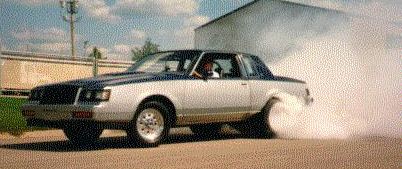I built this car by myself in 1/2 of a two car garage, with the exception of the rollcage and the frame notching, trans and engine machine and headwork. I built the engine to my specifications, myself, at ANS Performance, under Pete Barton's watchful eye. It's first outing was in June of '93. I ran the car the rest of '93 and 3/4 of the way into the '94 season. I'll bet I had about $22,000 - $23,000 total in the car, with probably about $16,000 in the motor, turbo, intercooler, fuel system, and DFI. But more than anything, I had time in the car.
During construction of the car, from mid-Feb '93 until mid-June '93, I averaged 55 hours a week on the car, on top of 45-50 hours at work.

Tom's car started life as a 1981 Regal, but has been converted to an awesome mid 9 second street legal car.
Nobody would suspect this "wolf in sheep's clothing" at the local cruise spot, would they?
Wheel's up and on the way to another mid 9 second pass!
| Torque Converter | Art Carr 4000 stall 9" |
| Transmission | TH-400 by Jimmy's Transmissions. Can't say enough about his work. Superb. I used an Art Carr Transbrake. |
| Shifter | B&M Megashifter, then a Dixie Air shifter. |
| Driveshaft | Custom with HD Spicer 1350 U-joints. |
| Rear End | Ford 9" with 35 spline axles from Moser. Aluminum center section with 3.89:1 gears and spool from Currie. |
| Brakes | Front: Stock Rear: Wilwood Disc Master cylinder kit from Art Morrison (manual) |
| Wheels and Tires | Front: Weld Draglite 15" x 3.5" with Moroso skinnies.
Rear: Weld Draglite 15" x 8" with 29.5 x 10.5" Mickey Thompson slicks |
| Steering | Manual box from a junkyard somewhere in Massachusetts (thanks Pete B!) out of an El Camino. |
| Front Suspension | All brand new pieces (ball joints, tie rods, drag link, etc.) with Carerra 90:10 shocks. No swaybar. |
| Rear Suspension | I raced the car in '93 with the factory suspension (boxed uppers and SouthSide lowers) and got a best 60' of 1.38. The car was a handful to drive. Launch too soft, the car would push left.
Launch too hard, the car would push right. Over the '93/'94 winter, I installed a ladder bar kit from Art Morrison, and this solved all my launching problems. I could run the car without making any steering corrections whatsoever. The car was like an arrow. Best 60' with the ladder bars: 1.36. |
| Frame | Notched rear frame rails. |
| Roll cage | 10 point kit from Art Morrison. |
| Body | All steel panels and factory glass windows except for fiberglass bumpers and Lexan sheet in place of factory Astroroof. I installed an '87 header panel and grill, as well as '87 taillights for a more modern look. |
| Interior | Jaz bucket seats, factory rear seats, factory door panels, factory dash with Auto Meter gauges installed in place of factory gauges (Look at any '81-'82 Regal, and you'll see how perfect the dash is for this setup). Radio removed and replaced with a switch plate for intercooler pump, master cutoff, cooling fan, and night racing lights.
I used the night racing light switch to illuminate the third brake light I installed and the gauges. This way, I wouldn't need to light up the front and rear marker lights while racing at night. The gauge lights still lit from the factory light switch, I just added diodes in each line to prevent feedback to the other system. I installed a Grant steering wheel with removable kit to help entrance and exit from the car. Power windows and doors were full functioning. I left the heater controls in for looks only. |
| Gauges | Auto Meter Tach, boost gauge, coolant temp, trans temp, oil pressure, and fuel pressure with isolator. |
| Trunk | Battery with shutoff. |
I tried running a Moroso electric water pump drive on the car for a while, but it didn't perform as well as the stock one.
Since I was running both a transbrake and a linelock, and since I didn't want to have two transbrake/linelock buttons and associated wiring snaking through the interior, I set them both up to run off of one button. I would flip a dash mounted switch down, go into the water box, press the button, do my burnout. As I went to the line, flip the dash switch up, stage, press the same button, which now would activate the transbrake. The switch I used was a three position, so for day-to-day driving I would set it in the middle position, which connected the button to nothing for safety.
| 9/93 | 9.676@140.53 Union Grove, Wisconsin (with exhaust system) 50 degree weather, absolutely perfect conditions |
| 10/93 | 9.75@138.40 Grapple at the Gateway, Fairfield, IL (exhaust, against Billy Glidden) |
| 5/94 | 9.654@138.64 GS Nats (without exhaust, but with ladder bars) Far from perfect conditions |
| 6/94 | 9.79@138.4 Byron Dragway, Rockford, IL (added steel bumpers) 105 degree weather. BRUTAL conditions. |
Typically, I would run 6.1x @ 113 in the eighth mile. At the Nats in '94 during the first round of eliminations, I dialed a 9.68 and had to start letting off at the 900' mark and then coast/brake to a win. I ran a 9.70 @ 123, but my eighth mile was a 6.03 @ 114.5!! Even though I got $400 for the win (the rest of eliminations got called for rain), I'd give the money back in a heartbeat for the time slip that coulda' been!!!
Race Weight: With the fuel cell 3/4 full, and myself aboard (175 lbs), the car weighed 3250 lbs with fiberglass bumpers and 3325 lbswith steel bumpers.


